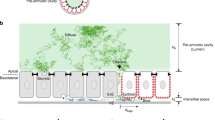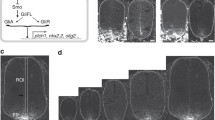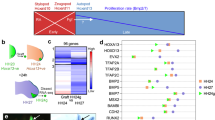Abstract
In the development of organs, multiple morphogen sources are often involved, and interact with each other. For example, the apical ectodermal ridge (AER) and the zone of polarizing activity (ZPA) are major morphogen sources in the limb bud formation of vertebrates. Fgf expression in the AER and Shh expression in the ZPA are maintained by their positive feedback regulation mediated by diffusible molecules, FGF and SHH. A recent experimental observation suggests that the FGF-signal regulates the Shh expression in a feed-forward manner with activation and repression regulatory pathways. We study the coupled dynamics of Shh expression in the ZPA and Fgf expression in the AER, and the relationship of the relative position between AER and ZPA. We first show that with the feed-forward regulation only, the peak of ZPA activity can be formed distant from the AER as observed experimentally. Then, we clarify that the robustness of the ZPA spatial pattern to changes in system parameters is enhanced by adding the feedback regulation between the AER and the ZPA. Furthermore, sensitivity analysis shows that there exists the optimal feedback strength where the robustness is the most improved.
Similar content being viewed by others
References
Boulet, A.M., Moon, A.M., Arenkiel, B.R., Capecchi, M.R., 2004. The roles of Fgf4 and Fgf8 in limb bud initiation and outgrowth. Dev. Biol. 273, 361–372.
Capdevila, J., Tsukui, T., Esteban, C.R., Zappavigan, V., Belmonte, J.C.I., 1999. Control of vertebrate limb outgrowth by the proximal factor Meis2 and distal antagonism of BMPs by gremlin. Cell 4, 839–849.
Charite, J., Graaff, W., Shen, S., Deschamps, J., 1994. Ectopic expression of Hox-8 cause duplication of the ZPA in the forelimb and homeotic transformation of axial structures. Cell 78, 589–601.
Charite, J., McFadden, D.G., Olson, E.N., 2000. The bHLH transcription factor of dHAND controls Sonic hedgehog expression and establishment of the zone of polarizing activity during limb development. Development 127, 2461–2470.
Chaturvedi, R., Huang, C., Izaguirre, J.A., Newman, S.A., Glazier, J.A., Alber, M., 2004. A hybrid discrete-continuum model for 3-D skeletogenesis of the vertebrate limb. In: Lecture Notes in Computer Science, vol. 3305. pp. 543–552.
Chiang, C., Litingtung, Y., Harris, M.P., Simandl, B.K., Li, Y., Beachy, P.A., Fallon, J.F., 2001. Manifestation of the limb prepattern: limb development in the absence of sonic hedgehog function. Dev. Biol. 236, 421–435.
Dillon, R., Othmer, H.G., 1999. A mathematical model for outgrowth and spatial pattering of the vertebrate limb bud. J. Theor. Biol. 197, 295–330.
Drossopoulou, G., Lewis, K.E., Sanz-Ezquerro, J.J., Nikbakht, N., McMahon, A.P., Hofmann, C., Tickel, C., 2000. A model for antero-posterior patterning of the vertebrate limb based on sequential long- and short-range Shh signaling and Bmp signaling. Development 127, 1337–1348.
Dudley, A.T., Tabin, C.J., 2000. Constructive antagonism in limb development. Curr. Opin. Genet. Dev. 10, 387–392.
Fernandez-Teran, M., Piedra, M.E., Kathiriya, I.S., Srivastava, D., Rodriguez-Rey, J.C., Ros, M.A., 2000. Role of dHAND in the antero-posterior polarization of the limb bud: implications for the Sonic hedgehog pathway. Development 127, 2133–2142.
Ferrell, J.E. Jr., 1998. How regulated protein translocation can produce switch-like responses. TIBS 23, 461–465.
Goetz, J.A., Suber, L.M., Zeng, X., Robbins, D.J., 2002. Sonic Hedgehog as a mediator of long-range signaling. BioEssays 24, 157–165.
Goldbeter, A., Koshland, D.E. Jr., 1981. An amplified sensitivity arising from covalent modification in biological systems. Proc. Natl. Acad. Sci. 78, 6840–6844.
Goldbeter, A., Koshland, D.E. Jr., 1984. Ultrasensitivity in biochemical systems controlled by covalent modification. J. Biol. Chem. 259, 14441–14447.
Hentschel, H., Glimm, T., Glazier, J., Newman, S., 2004. Dynamical mechanism for skeletal pattern formation in the vertebrate limb. Proc. R. Soc. Lond. B. 271, 1713–1722.
Ishihara, S., Fujimoto, K., Shibata, T., 2005. Cross talking of network motifs in gene regulation that generates temporal pulses and spatial stripes. Genes Cells 10, 1025–1038.
Johnson, R.L., Tabin, C.J., 1997. Molecular models for vertebrate limb development. Cell 90, 979–990.
Kholodenko, B.N., Hoek, J.B., Westerhoff, H.V., Brown, G.C., 1997. Quantification of information transfer via cellular signal transduction pathways. FEBS Lett. 414, 430–434.
Kraus, P., Fraidenraich, D., Loomis, C.A., 2001. Some distal limb structures develop in mice lacking Sonic hedgehog signaling. Mech. Dev. 100, 45–58.
Laufer, E., Nelson, C.E., Johnson, R.L., Morgan, B.A., Tabin, C.J., 1994. Sonic hedgehog and Fgf-4 Act through a signaling cascade and feedback loop to integrate growth and patterning of the developing limb bud. Cell 79, 993–1003.
Lewandoski, M., Sun, X., Martin, G.R., 2000. Fgf8 signalling from the AER is essential for normal limb development. Nat. Genet. 26, 460–463.
Lu, P., Minowada, G., Martin, G.R., 2006. Increasing Fgf4 expression in the mouse limb bud causes polydactyly and rescues the skeletal defects that result from loss of Fgf8 function. Development 133, 33–42.
Maini, P.K., Solursh, M., 1991. Cellular mechanisms of pattern formation in the developing limb. Int. Rev. Cytol. 129, 91–133.
Mangan, S., Alon, U., 2003. Structure and function of the feed-forward loop network motif. Proc. Natl. Acad. Sci. 100, 11980–11985.
Mangan, S., Itzkovitz, S., Zaslaver, A., Alon, U., 2006. The incoherent feed-forward loop accelerates the response-time of the gal system of Escherichia coli. J. Mol. Biol. 356, 1073–1081.
Martin, G.R., 1998. The roles of FGFs in the early development of vertebrate limbs. Genes Dev. 12, 1571–1586.
McGlinn, E., Tabin, C.J., 2006. Mechanistic insight into how Shh patterns the vertebrate limb. Curr. Opin. Genet. Dev. 16, 426–432.
Melen, G.J., Levy, S., Barkai, N., Shilo, B.Z., 2005. Threshold responses to morphogen gradients by zero-order ultrasensitivity. Mol. Syst. Biol. 13
Michos, O., Panman, L., Vintersten, K., Beier, K., Zeller, R., Zuniga, A., 2004. Gremlin-mediated BMP antagonism induces the epithelial-mesenchymal feedback signaling controlling metanephric kidney and limb organogenesis. Development 131, 3401–3410.
Miura, T., Shiota, K., Morriss-Kay, G., Maini, P.K., 2006. Mixed-mode pattern in Doublefoot mutant mouse limb—turing reaction-diffusion model on a growing domain during limb development. J. Theor. Biol. 240, 562–573.
Moon, A.M., Capecchi, M.R., 2000. Fgf8 is required for outgrowth and pattering of the limbs. Nat. Genet. 26, 455–459.
Murray, J.D., Maini, P.K., Tranquillo, R.T., 1988. Mechanochemical models for generating biological pattern and form in development. Phys. Rep. 171, 59–84.
Newman, S.A., Frisch, H.L., 1979. Dynamics of skeletal pattern formation in developing chick limb. Science 205, 662–668.
Niswander, L., 2002. Interplay between the molecular signals that control vertebrate limb development. Int. J. Dev. Biol. 46, 877–881.
Niswander, L., Jeffrey, S., Martin, G.R., Tickle, C., 1994. A positive feedback loop coordinates growth and patterning in the vertebrate limb. Nature 371, 609–612.
Oster, G.F., Murray, J.D., Maini, P.K., 1985. A model for chondrogenic condensations in the developing limb—the role of extracellular matrix and cell tractions. J. Embryol. Exp. Morphol. 89, 93–112.
Pagan, S.M., Ros, M.A., Tabin, C., Fallon, J.F., 1996. Surgical removal of limb bud Sonic hedgehog results in posterior skeletal defects. Dev. Biol. 180, 35–40.
Panman, L., Zeller, R., 2003. Patterning the limb before and after SHH signalling. ASGBI 202, 3–12.
Panman, L., Galli, A., Lagarde, N., Michos, O., Soete, G., Zuniga, A., Zeller, R., 2006. Differential regulation of gene expression in the digit forming area of the mouse limb bud by SHH and gremlin 1/FGF-mediated epithelial-mesenchymal signaling. Development 133, 3419–3428.
Riddle, R.D., Johnson, R.L., Laufer, E., Tabin, C.J., 1993. Sonic hedgehog mediates the polarizing activity of the ZPA. Cell 75, 1401–1416.
Rowe, D.A., Fallon, J.F., 1982. The proximodistal determination of skeletal parts in the developing chick leg. J. Embryol. Exp. Morphol. 68, 1–7.
Saunders, J.W. Jr., 1948. The proximo-distal sequence of origin of the parts of the chick wing and the role of the ectoderm. J. Exp. Zool. 108, 363–403.
Saunders, J.W. Jr., Gasseling, M.T., 1968. Ectoderm-mesenchymal interaction in the origins of wing symmetry. In: Fleischmajer, R., Billingham, R.E. (Eds.), Epithelial-Mesenchymal Interactions, pp. 78-97.
Shen-Orr, S.S., Milo, R., Mangan, S., Alon, A., 2002. Networks motifs in the transcriptional regulation network of Escherichia coli. Nat. Genet. 31, 64–69.
Summerbell, D., 1974. Quantitative analysis of the effect of excision of the AER from the chick limb-bud. J. Embryol. Exp. Morph. 32, 651–660.
Sun, X., Lewandoski, M., Meyers, E.N., Liu, Y.H., Maxson, R.E. Jr., Martin, G.R., 2000. Conditional inactivation of Fgf4 reveals complexity of signalling during limb bud development. Nat. Genet. 25, 83–86.
Sun, X., Mariani, F.V., Martin, G.R., 2002. Functions of FGF signalling from the apical ectodermal ridge in limb development. Nature 418, 501–508.
Tanaka, M., Cohn, M.J., Ashby, P., Davey, M., Martin, P., Tickle, C., 2000. Distribution of polarizing activity and potential for limb formation in mouse and chick embryos and possible relationships to polydactyly. Development 127, 4011–4021.
TeWelscher, P., Fernandez-Teran, M., Ros, M.A., Zeller, R., 2002. Mutual genetic antagonism involving GLI3 and dHAND prepatterns the vertebrate limb bud mesenchyme prior to SHH signaling. Genes Dev. 16, 421–426.
Verheyden, J.M., Lewandoski, M., Deng, C., Harfe, B.D., Sun, X., 2005. Conditional inactivation of Fgfr1 in mouse defines its role in limb bud establishment, outgrowth and digit patterning. Development 132, 4235–4245.
Wolpert, L., 1969. Positional information and the spatial pattern of cellular differentiation. J. Theor. Biol. 25, 1–47.
Wolpert, L., 1998. Principles of Development. Oxford University Press, Oxford.
Zuniga, A., Haramis, A.G., McMahon, A.P., Zeller, R., 1999. Signal relay by BMP antagonism controls the SHH/FGF4 feedback loop in vertebrate limb buds. Nature 401, 598–603.
Author information
Authors and Affiliations
Corresponding author
Rights and permissions
About this article
Cite this article
Hirashima, T., Iwasa, Y. & Morishita, Y. Distance between AER and ZPA Is Defined by Feed-Forward Loop and Is Stabilized by their Feedback Loop in Vertebrate Limb Bud. Bull. Math. Biol. 70, 438–459 (2008). https://doi.org/10.1007/s11538-007-9263-4
Received:
Accepted:
Published:
Issue Date:
DOI: https://doi.org/10.1007/s11538-007-9263-4




